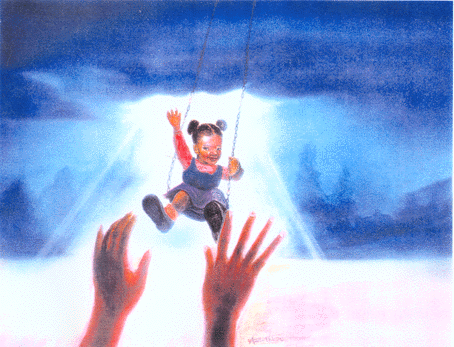Figure 1. At the swings.
Original crayon drawing by Arnold Jimenz
Commissioned by Glenda-mae Greene, March 1998

Swing Metaphor

| She pushed sweat beading her brow and i was born Smile for Mommy, baby she pushed and we rocked in warm symmetry i suckled at her breast Hush, little baby, don't say a word She pushed her up-stretched palms warm against my back and i soared into the summer sky Higher, Mommy, i am flying! She pushed i went further than she ever had I pumped others prompted I found my strengths We pushed I graduated from high school from adolescence from college from the boxed-in feeling I pushed and pulled it seemed impossible W'en yu han' in de tiga mout' Rub he 'ead I nudged the younger ones soared I pushed as we sat together on the swing chair my mother and I considering life- the pain of this the joys of that We found our place together and separate. |
"Metaphor is the backbone of social science writing, and like a spine, it bears weight, permits movement, links parts together into a functional coherent whole-and is not immediately visible" (Richardson, 1991, p. 18). The study's controlling metaphor is indeed a potent way of seeing ordinary things differently-in different forms and from different perspectives, thus "deepening meaning, expanded awareness, and enlarging understanding" (Eisner, 1997b, p. 5). Figure 1, which I commissioned for this study, reflects the metaphoric themes discussed below that informs this study.
The hands in the picture, however, brings a new perspective to the foreground of the inquiry and enlarge my understanding. The hands, unmistakably feminine, are both supportive and instrumental. They soothe and they motivate. At first glance, they are accepted as the mother's hands. On further reflection, a link not immediately visible becomes clear. They can just as easily symbolize the school teacher's hands. They represent the link between familial and school settings.
Silver's precious mother-memory evolved to become the controlling metaphor for this study because it signaled a plethora of possible meanings. The underlying assumption of the scene is that role modeling on the swings-realistic or vicarious-occurred here and the rewards were pleasurable. Young Silver had most likely seen others enjoying themselves at the swings and was eager to follow suit.
The repetition, which is a requisite for the act of swinging brings to mind much of what is required in learning; it is active and ultimately self-regulatory as the child learns to pump and control her own soaring. The notion of soaring reminds one that the child is given the freedom to soar, explore a new space, unbridled by limiting institutional restraints.
This story also illustrates the close and reciprocal relationship inherent in the mother-daughter bond Silver shared with her mother. Inherent in the tale is the implicit and safety-producing knowledge that her mother "got her back," a phrase that implies safety. Someone whom she trusts is watching out of her. The tacit assumption here is that the child is given the freedom to soar, explore a new space, unbridled by limiting institutional restraints.
The context, open spaces and warm sun, rife with symbolism of freedom, nurturance, and optimism. References to space abound in the interview transcripts. Space, as the women story it, has a myriad meanings. First, it reflects the possibility of personal freedom. It "refers to the self-determination; it has little to do with connectedness or being together in community" (Greene, 1988, p. 1). It illuminates the freedom that each woman has to choose her own way, unfettered by obligation and relations, as Eboni discovers.
Space also describes the inner space which empowered the woman to develop a new way of thinking. Silver describes in physical terms 'that li'l stretch of road' as the site for her private reflective space.
Allusions to space in the context of a respite "unconceal" (Heidegger, 1971, p. 54), an open public place where each woman sought solace and renewal. Eboni and Silver describe nearby parks as an antidote for cramped apartment living. This space is a self-selected site for temporary isolation from the clutter of communal living. It is also an antidote for Jade's 'boxed-in-feeling'.
Finally, space is the site for creativity. Silver stories it as the forum for an embryonic novel. Eboni uses the hours in her country garden to spend time alone with her thoughts while supplementing the vegetables for her family table. Jade uses it as the site for remembering her roots if she is in the tropics. In essence, the notion of space privileges the power of choice, independence, creativity, and posibility.
The poem which follows is predicated on the swing metaphor. It illuminates the nurturing and motivating which the women storied. Working with the developmental motif which under grids this study, I sought to "touch the impalpable" and guide readers to "see with the eyes of the heart" (Pas, cited in Glesne, 1997, p. 214).